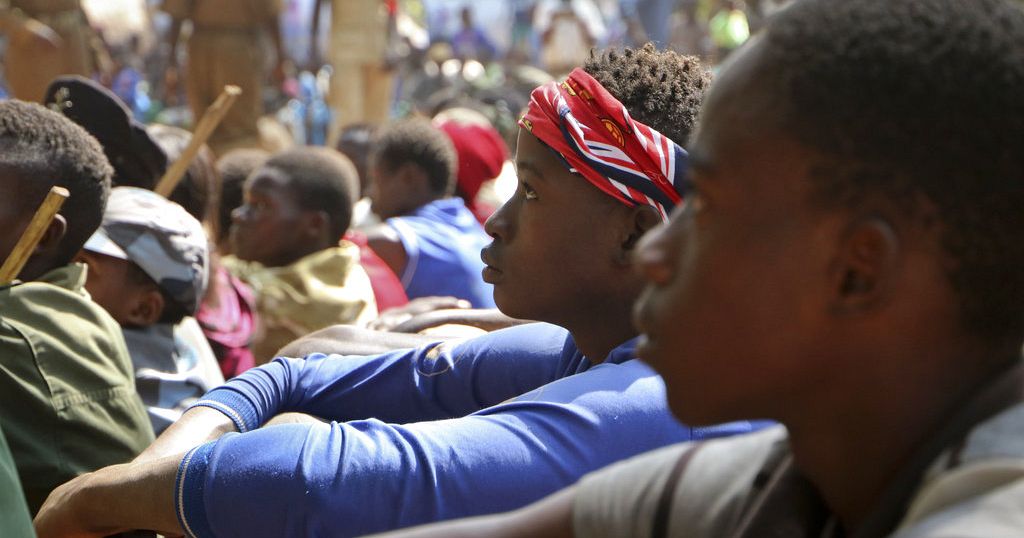South Sudan frees child soldiers, pledges education over army – africanews.com

Report on the Release of Child Soldiers in South Sudan and Progress Towards Sustainable Development Goals
Introduction: Advancing Child Protection in South Sudan
Recent developments in Yambio, Western Equatoria, indicate progress in South Sudan’s commitment to the Sustainable Development Goals (SDGs), particularly those concerning child welfare and peace. The South Sudan People’s Defence Forces (SSPDF) have officially released a number of children from their ranks, a critical step in aligning with international human rights standards and achieving SDG 16 (Peace, Justice and Strong Institutions).
Commitment to SDG 16: Peace, Justice and Strong Institutions
The release directly addresses SDG Target 16.2, which aims to end abuse, exploitation, trafficking, and all forms of violence against children. The SSPDF has publicly affirmed its dedication to this goal.
- Brigadier Akech Maker, SSPDF Brigade 16 Commander, stated, “We, in the SSPDF, will not allow the recruitment of children into the army.”
- This policy supports the development of accountable and transparent institutions as mandated by SDG 16.
- The SSPDF has committed to redirecting interested children towards educational pathways, reinforcing the link between peace and development.
Reintegration Process: A Multi-faceted Approach to SDGs 3, 4, and 8
A collaborative framework has been established to ensure the successful transition of the released children back into civilian life. This process is managed by multiple stakeholders and is designed to support several SDGs.
Key Reintegration Activities:
- Disarmament, Demobilisation, and Reintegration (DDR): Officials are conducting registration and verification to formally process the children, a foundational step for their reintegration and a measure to prevent re-recruitment, contributing to SDG 8.7 (End child labour, including use of child soldiers).
- Psychosocial Support: In line with SDG 3 (Good Health and Well-being), UNICEF and social workers are providing essential psychological services to help the children adapt and recover from trauma.
- Educational and Vocational Pathways: To support SDG 4 (Quality Education) and SDG 8 (Decent Work), children are provided with learning materials and assessed for their needs, including options for formal schooling or skills training. Clement Gbatanawo of UNICEF confirmed plans to “assess their needs in terms of skills or what they would like to go for.”
Collaborative Monitoring and SDG 17: Partnerships for the Goals
The success of this initiative relies on strong partnerships, a core principle of SDG 17. The joint efforts of the SSPDF, the UN Mission in South Sudan (UNMISS), UNICEF, and the national DDR commission exemplify this goal in action.
- Sustained Monitoring: UNMISS and DDR will continue to monitor the children to ensure the reintegration is permanent. Hellen Ernasio, Chairperson of DDR in Western Equatoria, affirmed, “We shall continue monitoring to see that they are not there so that our army is clean from that list of shame.”
- Prevention of Re-recruitment: UNMISS Child Protection Officer Rita Bampo emphasized that the mission will work to ensure “there is no power to pull them back into the armed group or any armed force.”
- Ongoing Challenge: Despite this progress, UNICEF estimates that approximately 19,000 children remain associated with armed forces in South Sudan, highlighting the need for continued and intensified collaborative action to achieve the SDGs.
1. Which SDGs are addressed or connected to the issues highlighted in the article?
The article on the release of child soldiers in South Sudan directly addresses and connects to the following Sustainable Development Goals (SDGs):
-
SDG 16: Peace, Justice and Strong Institutions
This is the most prominent SDG in the article. The entire focus is on ending the recruitment of children by armed forces, which is a core component of promoting peaceful and inclusive societies. The efforts of the UN Mission in South Sudan (UNMISS), the South Sudan People’s Defence Forces (SSPDF), and UNICEF to release, reintegrate, and protect these children are direct actions towards building stronger, more just institutions that protect the rights of the most vulnerable.
-
SDG 8: Decent Work and Economic Growth
The use of child soldiers is explicitly defined as one of the worst forms of child labor. The article’s discussion of ending this practice is therefore directly linked to the goal of eradicating forced labor and the worst forms of child labor.
-
SDG 4: Quality Education
The article highlights education as a key alternative to military life for these children. The SSPDF Commander states, “If a child shows interest, we will guide them towards education instead.” Furthermore, UNICEF’s provision of “learning materials” and assessment for “formal learning, or skills training” shows a clear connection to ensuring inclusive and equitable quality education for these vulnerable children.
2. What specific targets under those SDGs can be identified based on the article’s content?
Based on the article’s content, the following specific SDG targets can be identified:
-
Target 16.2: End abuse, exploitation, trafficking and all forms of violence against and torture of children.
This target is directly addressed by the central theme of the article: the release of child soldiers. The recruitment of children into armed forces is a severe form of exploitation and violence against children. The actions of UNMISS, SSPDF, and DDR to release, verify, and monitor these children to “make sure no children return to combat” are concrete steps towards achieving this target.
-
Target 8.7: Take immediate and effective measures to eradicate forced labour, end modern slavery and human trafficking and secure the prohibition and elimination of the worst forms of child labour, including recruitment and use of child soldiers, and by 2025 end child labour in all its forms.
This target is explicitly relevant as it specifically names the “recruitment and use of child soldiers” as one of the worst forms of child labor to be eliminated. The article’s report on the release of children by the SSPDF is a direct measure of progress against this target.
-
Target 4.5: By 2030, eliminate gender disparities in education and ensure equal access to all levels of education and vocational training for the vulnerable, including persons with disabilities, indigenous peoples and children in vulnerable situations.
Released child soldiers are a clear example of “children in vulnerable situations.” The article describes efforts to support them through “formal learning, or skills training,” which directly aligns with the goal of ensuring they have equal access to education and vocational opportunities to successfully reintegrate into civilian life.
3. Are there any indicators mentioned or implied in the article that can be used to measure progress towards the identified targets?
Yes, the article mentions and implies several indicators that can be used to measure progress:
-
Indicator for Targets 16.2 and 8.7: Number of child soldiers.
The article provides a specific figure: “UNICEF estimates that about 19,000 child soldiers in South Sudan.” This number serves as a baseline indicator for the scale of the problem. Progress can be measured by the reduction of this number over time. The statement that “some children have just been released” refers to a decrease in this number, directly measuring progress.
-
Indicator for Targets 16.2 and 8.7: Number of children released and reintegrated.
While the article does not give a specific number for the recent release, the entire process described—the “official handover ceremony,” “registration and verification processes,” and “reintegration process”—implies that the number of children successfully released and reintegrated is a key performance indicator used by the organizations involved (UNMISS, UNICEF, DDR) to track their success.
-
Implied Indicator for Target 4.5: Number of former child soldiers enrolled in education or vocational training.
The article implies this indicator through the actions of UNICEF and the statement by the SSPDF commander. UNICEF’s plan to “assess their needs in terms of skills or what they would like to go for, formal learning, or skills training” suggests that a key measure of successful reintegration will be the number or proportion of these children who are enrolled in educational or skills-based programs.
4. Create a table with three columns titled ‘SDGs, Targets and Indicators” to present the findings from analyzing the article.
| SDGs | Targets | Indicators |
|---|---|---|
| SDG 16: Peace, Justice and Strong Institutions | Target 16.2: End abuse, exploitation, trafficking and all forms of violence against and torture of children. |
|
| SDG 8: Decent Work and Economic Growth | Target 8.7: …secure the prohibition and elimination of the worst forms of child labour, including recruitment and use of child soldiers… |
|
| SDG 4: Quality Education | Target 4.5: …ensure equal access to all levels of education and vocational training for the vulnerable… and children in vulnerable situations. |
|
Source: africanews.com
What is Your Reaction?
 Like
0
Like
0
 Dislike
0
Dislike
0
 Love
0
Love
0
 Funny
0
Funny
0
 Angry
0
Angry
0
 Sad
0
Sad
0
 Wow
0
Wow
0















































/environment-climate-change-and-health-(ech)/water-sanitation-hygiene-and-health-(wsh)/landfill-tuvalu-36092.tmb-1200v.jpg?sfvrsn=5c21fe40_1#)


.jpg.webp?itok=0ZsAnae9#)


























